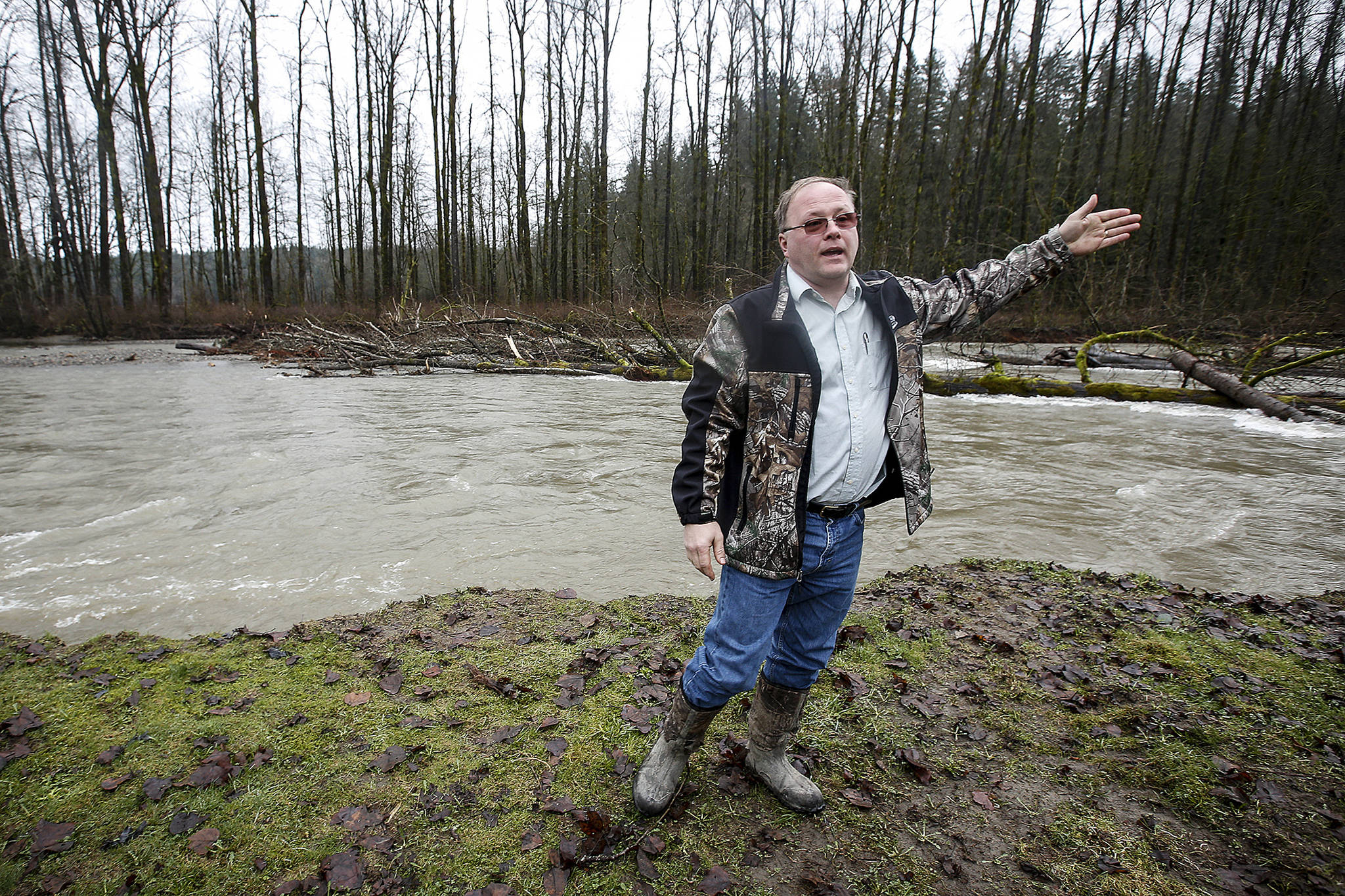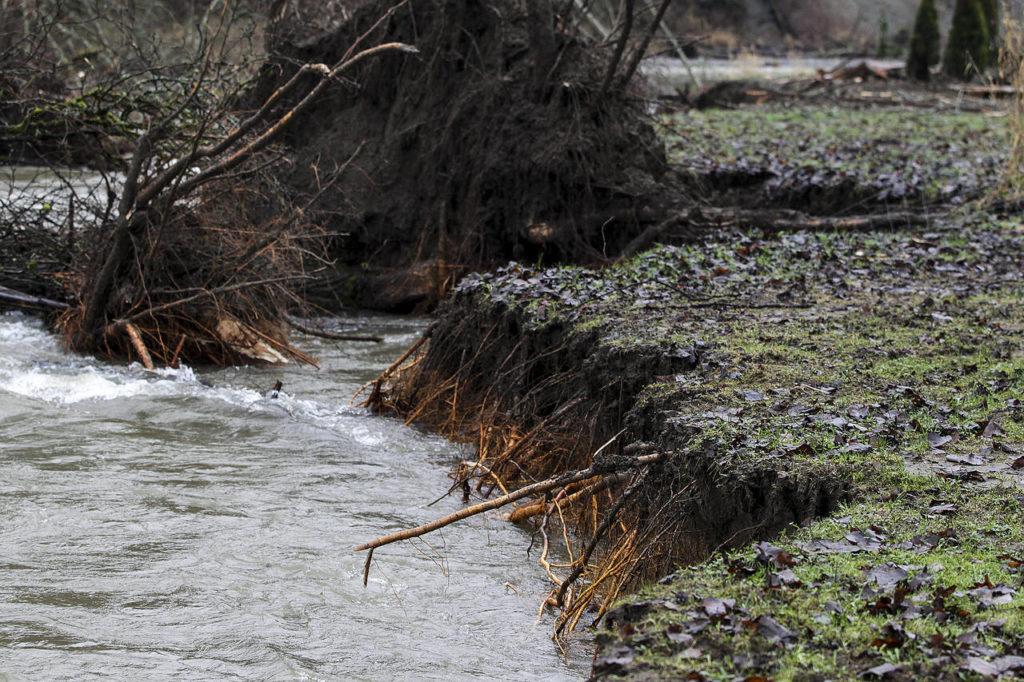LOCHSLOY — The river swallowed Marek Novy’s office around 4 a.m. on Super Bowl Sunday.
Neighbor Greg Wilson’s office was swept away the following evening. Dawn Roberts, a few doors down, watched it go. She saw her neighbors working by floodlight to disconnect power and salvage what they could. She described the office floating down the swollen river, “like a houseboat.”
For years, homeowners in the Lochaven neighborhood along the Pilchuck River between Lake Stevens and Granite Falls have been fighting a losing battle against erosion. They’ve lost a lot of land, dozens of trees and some structures — offices, gazebos, a well, a retaining wall. For some, the river is getting precariously close to their houses.
“When it floods down here, you can lose feet in an hour. You can stand there and watch it,” Wilson said. “At this point, we don’t even want to fix it. We just want to stop it where it’s at.”
The current undercuts the west bank and can rip away chunks of land during floods. Novy estimates he’s lost up to 50 yards — half a football field — since late December.
The homeowners sought an emergency permit in 2015 to shore up the bank and put in groins to divert the current. Though approved by county and state officials, it was denied by the Army Corps of Engineers, which said it didn’t meet the definition of an emergency.
The neighbors wonder: If their situation isn’t an emergency, then what is?
At one point, they lined up volunteers and donated materials to start work. Insurance costs and permitting delays, however, resulted in them losing the help.
In 2016, the neighbors voted to form the Lochsloy Pilchuck Flood Control District, a governing body that allows them to levy taxes on the 16 properties for a project to stop the erosion. Then they saw the estimated cost: more than $1.3 million, according to a 2016 presentation by county engineers. Even spread over 30 years, it could add thousands of dollars a year to tax bills.
The flood control district “was our last ditch effort,” said Roberts, one of three commissioners. “But I can’t tax people out of their homes. I just can’t do it.”
During high water in December, trees were pulled into a log jam in the river. They came from Novy’s yard, and he worked to clear the jam and put ecology blocks along his bank. He worried that pressure building up behind the jam would cause the river to finally take one of his neighbors’ homes. His house is uphill, farther from the water.
“I risked my life to try to clear the dam,” he said.
That was the weekend before Christmas. Within days, county and state officials arrived, ordering him to stop and informing him it was illegal to work in the river.
As soon as they try to do something, someone’s there telling them they can’t, said Wilson, Novy’s neighbor.
“It’s frustrating when you keep asking, ‘What can we do? What can we do?’ and they can’t help you,” he said.
Money and time
The neighbors feel trapped. They believe Snohomish County has made the erosion worse, and want the government to take emergency steps to stave off further problems.
Public works officials contend they’ve tried to help the homeowners find solutions. But it all takes money, and time. Neighbors say they have neither.
The flood control district is well on its way toward being able to do something to protect homes, public works director Steve Thomsen said. The next step is an assessment system to fund a project, then turning in a plan to the county. A project could be done in phases to make it more affordable, he said.
“I’ve seen other flood control districts do it,” Thomsen said.
The most similar district is in Robe Valley, where people living along the South Fork Stillaguamish River lost three homes to flooding in 2003.
Homeowners there formed a district in 2006 and the county helped secure a federal grant for an $800,000 project to stabilize the bank. New rock weirs collect sediment and logs, building up the bank.
The money came from a federal program that can be used to relieve “imminent threat to life and property created by a natural disaster,” according to a 2007 profile of the project.
When the Lochaven homeowners visited Robe Valley in 2015, they weren’t able to connect with commissioners from that district. A woman who lives there explained how water still flowed through her yard during floods, though erosion seemed to have stopped.
The homeowners need to get a professional engineer on board and figure out finances, Thomsen said.
“You can’t access any of these tools until you get past first base, which is to set up your budget,” he said.
False hope
Novy, 45, bought his home two years ago. He lives there with his wife and three children. Much of the once-long back yard is gone, along with his secondary well and a gazebo and treehouse, each equipped with water and electricity. The 400-square-foot treehouse was his home office. He designs floors.
Planting trees is one of the few things he’s allowed to do to protect his property, he said. He’s planted more than 100. He understands that there are limits on work near rivers, but figures having tons of soil, dozens of trees and entire structures fall in must be more harmful than removing a log jam or bracing the bank.
Though he’s a commissioner now, along with Roberts and Wilson, Novy voted against forming the flood district. He didn’t think they could afford a fix.
“It just gives a false hope to some of the people,” he said. “But when you’re living in fear that you’re going to be swimming to Snohomish, you want any kind of hope.”
Nearby Highway 92 and 64th Street NE are listed in the Pilchuck’s 100-year floodplain. The street Novy and his neighbors live on, 152nd Avenue NE, is not.
The situation on the Pilchuck is not isolated. Spots along every local river suffer repetitive flood losses. In a 100-year flood, damage could approach $130 million countywide, according to the county’s hazard mitigation plan.
“The scale of what we’re talking about is extensive,” said Jason Biermann, the county’s emergency management director.
Buyouts can take years. In the Jordan River Trails neighborhood near Arlington, along the South Fork Stillaguamish, homeowner Rob Mott began working with the county in 2014. The county purchased the home in July and it was finally torn down this fall.
Much of the county’s recent flood buyouts have focused on properties destroyed by the deadly Oso mudslide in 2014. Not all of them, though.
Since 2015, the county has acquired three homes in other areas through federal flood buyout programs, said Fay Lim, a county public works spokeswoman. Those buyouts totaled about $750,000. The Federal Emergency Management Agency provided at least three-quarters of the money.
The county has started a grants process for 10 properties through FEMA during the past three years, totalling about $2.6 million.
Meanwhile, floods have become more common and, increasingly, tend to dump more sediment in the rivers, Biermann said.
“Not too much to ask”
The Lochaven homeowners have been asking the county to help pay for a project to protect their homes.
County officials note that they can’t use public money to benefit private land.
But the homeowners believe the county needs to take some responsibility for their situation. They contend that pillars on the county’s old bridge, just upstream, worsened erosion. The bridge was replaced with a clear span in 2016, a $3.2 million project.
Some are considering legal action. They feel stuck on properties they can neither save nor sell.
Roberts and her husband filed a damage claim against the county in 2016. It focused on wood structures the county placed under the old bridge a few years earlier to protect the support pillars, arguing that they directed water toward her bank and guided the river into a new channel.
A legal case might make the argument that the county’s actions amounted to an unconstitutional taking of their land. It also might make a claim of negligence.
A 2013 study examined the changing course of the river, but was unable to draw any conclusions about how the old bridge pillars might have affected erosion. Removing the pillars was expected to cause some change, but the direction could not be predicted. No follow-up study has been done. The study acknowledged that the piers might have contributed “toward deflection of the flow toward the right bank.”
In a 2015 letter, neighbors asked county leaders to work bank stabilization into plans for replacing the bridge, which connects to a private horse farm and several public parking spaces.
“This is not too much to ask, considering this bridge supports one property and we are asking for support for 10-14 properties,” wrote Bradley and Lisa Wasser.
But the money couldn’t go toward bank repair and protection, according to the county. Most of the project was paid for with federal funds specifically for bridge replacement.
Floated away
The Lochaven homeowners understand there are limits to what government can do, but hoped county leadership would step in.
County Councilman Nate Nehring has met with the neighbors about the erosion problems since taking office in early 2017.
“There’s a fundamental disagreement as to the responsibility of the county,” Nehring said. The bridge doesn’t seem to be the cause of erosion, he added.
Still, he’s sympathetic. Time is not on the homeowners’ side.
“I want to do anything I can to help them,” he said. “The thing that we can’t do, because it’s against the law, is to use county funds to fix the issue.”
He’d support a grant application, and said the district needs to move forward with an assessment system to pay for a project.
Meanwhile, the river has been eating away at the bank. The neighbors don’t have much money, and they’re not experts on grants or hazard-mitigation projects. They’ve tried to find a solution. They never know when a flood might take another chunk of land or one of their homes.
On Jan. 22, Greg Wilson stood on the county’s new bridge over the Pilchuck and watched the fast-moving water. He pointed to leaning trees, newly formed log jams and the way the river has curved drastically from its former channel.
“We’re completely lost,” he said. “The river might stay like this forever, and we might be fine. But we might have a flood next week. We just don’t know.”
Exactly two weeks later, his office fell in and floated away.
Kari Bray: 425-339-3439; kbray@heraldnet.com.
Talk to us
> Give us your news tips.
> Send us a letter to the editor.
> More Herald contact information.



























